Experimental Characterization of Raw Earth Properties for Modeling Their Hygrothermal Behavior
Abstract
:1. Introduction
2. Materials and Methods
2.1. Raw Earth
2.2. Straw
2.3. Mixing
- Mixing the raw earth alone for 5 min at 120 rpm
- Adding water and mixing for 5 min at 120 rpm
- Adding half the amount of fiber and kneading for 5 min at 120 rpm
- Adding the remaining fibers and kneading for 5 min at 120 rpm
2.4. Microstructure Observations
2.5. Thermal Conductivity
2.6. Specific Heat Capacity
2.7. Sorption Isotherms
2.8. Moisture Buffer Value (MBV)
2.9. Water Vapor Permeability
3. Results and Discussions
3.1. Experimental Characterization
3.1.1. Microstructure Observations
3.1.2. Thermal Conductivity
3.1.3. Specific Heat Capacity
3.1.4. Sorption Isotherms
3.1.5. Moisture Buffer Value (MBV)
3.1.6. Water Vapor Permeability
3.2. Numerical Simulation
3.2.1. Mathematical Model
- Macroscopically homogeneous, isotropic and rigid solid phase;
- Gas phase at constant and uniform pressure;
- Thermodynamic equilibrium between all phases present;
- No chemical reaction between phases;
- No heat transfer by radiation;
- No energy dissipation during flow;
- Wetting heat neglected.
3.2.2. Model Validation
3.2.3. Results
4. Conclusions
Author Contributions
Funding
Institutional Review Board Statement
Informed Consent Statement
Data Availability Statement
Acknowledgments
Conflicts of Interest
Nomenclature
| Specific heat capacity (J·kg−1·K−1) | |
| RH | Relative Humidity (%) |
| m | Mass (g) |
| T | Temperature (°C) |
| u | Water content of mass ratio (%) |
| w | Water content (kg·m−3) |
| Moisture storage capacity (%) | |
| p | Pressure (Pa) |
| Liquid water conductivity due to a thermal gradient (kg·m−1·s−1·K−1) | |
| R | Ideal gas constant (J·mol−1·K−1) |
| M | Molar mass of water (g·mol−1) |
| Total heat capacity (J·kg−1·K−1) | |
| Specific liquid enthalpy (J·kg−1) | |
| Hydraulic liquid conductivity (kg·s−1·m−1·Pa−1) | |
| Total moisture diffusivity coefficient (kg·m−1·s−1·Pa−1) | |
| Latent heat of vaporization of liquid water (J·kg−1) | |
| PCC | Phase Change Criterion |
| Subscripts | |
| s | solid |
| l | liquid |
| v | vapor |
| sat | saturation |
| Greek Symbols | |
| Density (kg·m−3) | |
| Thermal conductivity (W·m−1·K−1) | |
| Effective thermal conductivity (W·m−1·K−1) | |
| δ | Water vapor permeability (kg·s−1·m−1·Pa−1) |
| Heat transfer by convection due to the vapor pressure gradient coefficient (W·m−1·Pa−1) | |
References
- Climat, Air et Energie. Available online: https://librairie.ademe.fr/changement-climatique-et-energie/1725-climat-air-et-energie-9791029712005.html (accessed on 31 March 2022).
- The United Nations Environment Programme. Global Alliance for Buildings and Construction. Global Status Report for Buildings and Construction: Towards a Zero-Emissions, Efficient and Resilient Buildings and Construction Sector—Executive Summary; The United Nations Environment Programme: Nairobi, Kenya, 2020. [Google Scholar]
- Thongkamsuk, P.; Sudasna, K.; Tondee, T. Waste Generated in High-Rise Buildings Construction: A Current Situation in Thailand. Enrgy Proced. 2017, 138, 411–416. [Google Scholar] [CrossRef]
- Meyer, C. Concrete Materials and Sustainable Development in the USA. Struct. Eng. Int. 2004, 14, 203–207. [Google Scholar] [CrossRef]
- CSI: Our Agenda for Action. Available online: https://www.wbcsd.org/jlgbe (accessed on 31 March 2022).
- Réglementation Environnementale 2020: Réduire l’impact Carbone des Bâtiments Neufs (Dossier RE2020). Available online: http://www.cerema.fr/fr/actualites/RE2020 (accessed on 31 March 2022).
- Joffroy, T. Les Architectures de Terre Crue: Des Origines à Nos Jours. In Savoir & Faire: La terre; Jacquet, H., Ed.; Savoir & Faire: Paris, France, 2016; Volume La terre, pp. 333–347. [Google Scholar]
- Minke, G. Building with Earth: Design and Technology of A Sustainable Architecture. Available online: https://vdoc.pub/documents/building-with-earth-design-and-technology-of-a-sustainable-architecture-7n3qjrkm93p0 (accessed on 31 March 2022).
- Anger, R.; Fontaine, L. Grains de Bâtisseurs: La Matière En Grains, de la Géologie à l’Architecture; CRATerre: Villefontaine, France, 2005. [Google Scholar]
- Adams, C.; Lynne, E. Alternative Construction: Contemporary Natural Building Methods; John Wiley & Sons: Hoboken, NJ, USA, 2000. [Google Scholar]
- Keefe, L. Earth Building: Methods and Materials, Repair and Conservation; Routledge: Oxfordshire, UK, 2012; ISBN 978-1-134-35017-9. [Google Scholar]
- Ben-Alon, L.; Loftness, V.; Harries, K.A.; DiPietro, G.; Hameen, E.C. Cradle to Site Life Cycle Assessment (LCA) of Natural vs. Conventional Building Materials: A Case Study on Cob Earthen Material. Build. Environ. 2019, 160, 106150. [Google Scholar] [CrossRef]
- Hamard, E.; Cazacliu, B.; Razakamanantsoa, A.; Morel, J.C. Cob, a Vernacular Earth Construction Process in the Context of Modern Sustainable Building. Build. Environ. 2016, 106, 17. [Google Scholar] [CrossRef]
- Niroumand, H.; Zain, M.F.M.; Jamil, M. Various Types of Earth Buildings. Procedia Soc. Behav. Sci. 2013, 89, 226–230. [Google Scholar] [CrossRef] [Green Version]
- Evans, I.; Smiley, L.; Smith, M.G. The Hand-Sculpted House: A Philosophical and Practical Guide to Building a Cob Cottage; Chelsea Green Publishing: Chelsea, VT, USA, 2002. [Google Scholar]
- Ben-Alon, L.; Loftness, V.; Harries, K.A.; Hameen, E.C.; Bridges, M. Integrating Earthen Building Materials And Methods Into Mainstream Construction. J. Green Build. 2020, 15, 87–106. [Google Scholar] [CrossRef]
- Watson, L.; McCabe, K. The Cob Building Technique. Past, Present and Future. Inf. Constr. 2011, 63, 59. [Google Scholar] [CrossRef] [Green Version]
- Fabbri, A.; Morel, J.C.; Aubert, J.-E.; Bui, Q.-B.; Gallipoli, D.; Ventura, A.; Reddy, V.B.V.; Hamard, E.; Pelé-Peltier, A.; Abhilash, H.N. An Overview of the Remaining Challenges of the RILEM TC 274-TCE, Testing and Characterisation of Earth-Based Building Materials and Elements. RILEM Tech. Lett. 2021, 6, 150–157. [Google Scholar] [CrossRef]
- Moisture Movement in Porous Materials under Temperature Gradients. Eos Trans. Am. Geophys. Union 1957, 38, 222–232. [CrossRef]
- Ferroukhi, Y.; Djedjig, R.; Limam, K.; Belarbi, R. Hygrothermal Behavior Modeling of the Hygroscopic Envelopes of Buildings: A Dynamic Co-Simulation Approach. Build. Simul. 2016, 9, 501–512. [Google Scholar] [CrossRef]
- Remki, B.; Abahri, K.; Tahlaiti, M.; Belarbi, R. Hygrothermal Transfer in Wood Drying under the Atmospheric Pressure Gradient. Int. J. Therm. Sci. 2012, 57, 135–141. [Google Scholar] [CrossRef]
- NF EN ISO 17892-4. Available online: https://www.boutique.afnor.org/fr-fr/norme/nf-en-iso-178924/reconnaissance-et-essais-geotechniques-essais-de-laboratoire-sur-les-sols-p/fa166662/80069 (accessed on 31 March 2022).
- Rojat, F.; Hamard, E.; Fabbri, A.; Carnus, B.; McGregor, F. Towards an Easy Decision Tool to Assess Soil Suitability for Earth Building. Constr. Build. Mater. 2020, 257, 28. [Google Scholar] [CrossRef]
- Baize, D. Guide Des Analyses En Pédologie, 3rd ed.; Éditions Quae: Versailles, France, 2018. [Google Scholar]
- Barnaure, M.; Bonnet, S.; Poullain, P. Earth Buildings with Local Materials: Assessing the Variability of Properties Measured Using Non-Destructive Methods. Constr. Build. Mater. 2021, 281, 122613. [Google Scholar] [CrossRef]
- NF EN ISO 17892-12. Available online: https://www.boutique.afnor.org/fr-fr/norme/nf-en-iso-1789212/reconnaissance-et-essais-geotechniques-essais-de-laboratoire-sur-les-sols-p/fa187930/84021 (accessed on 31 March 2022).
- NF EN 933-9+A1. Available online: https://www.boutique.afnor.org/fr-fr/norme/nf-en-9339-a1/essais-pour-determiner-les-caracteristiques-geometriques-des-granulats-part/fa181706/41426 (accessed on 31 March 2022).
- Snell, C.; Callahan, T. Building Green: A Complete How-to Guide to Alternative Building Methods: Earth Plaster, Straw Bale, Cordwood, Cob, Living Roofs; Sterling Publishing Company, Inc.: New York, NY, USA, 2009. [Google Scholar]
- Phung, T.A. Formulation et Caractérisation d’un Composite Terre-Fibres Végétales: La Bauge. Ph.D. Thesis, Normandie Université, Caen, France, 2018. [Google Scholar]
- Engineering Properties of Cob as a Building Material. Available online: https://scialert.net/abstract/?doi=jas.2006.1882.1885 (accessed on 31 March 2022).
- Behim, M.; Cyr, M.; Clastres, P. Physical and Chemical Effects of El Hadjar Slag Used as an Additive in Cement-Based Materials. Eur. J. Environ. Civ. Eng. 2011, 15, 1413–1432. [Google Scholar] [CrossRef]
- Hwang, C.; Lin, C. Strength Development of Blended Blast-furnace Slag-cement Mortars. J. Chin. Inst. Eng. 1986, 9, 233–239. [Google Scholar] [CrossRef]
- Spezzani, L. Valorisation Énergétique Des Cultures Intermédiaires et Coproduits Agricoles; ValBiom: Gembloux, Belgium, 2014. [Google Scholar]
- Lam, P.S.W.; Sokhansanj, S.; Bi, X.; Lim, J.; Naimi, L.; Hoque, M.; Mani, S.; Womac, A.; Ye, X.; Narayan, S. Bulk Density of Wet and Dry Wheat Straw and Switchgrass Particles. Appl. Eng. Agric. 2008, 24, 351–358. [Google Scholar] [CrossRef]
- Koh, C.H.; Kraniotis, D. A Review of Material Properties and Performance of Straw Bale as Building Material. Constr Build Mater. 2020, 259, 120385. [Google Scholar] [CrossRef]
- Costes, J.-P.; Evrard, A.; Biot, B.; Keutgen, G.; Daras, A.; Dubois, S.; Lebeau, F.; Courard, L. Thermal Conductivity of Straw Bales: Full Size Measurements Considering the Direction of the Heat Flow. Buildings 2017, 7, 11. [Google Scholar] [CrossRef] [Green Version]
- Opoku, A.; Tabil, L.G.; Crerar, B.; Shaw, M.D. Thermal Conductivity and Thermal Diffusivity of Timothy Hay. Can. Biosyst. Eng. 2006, 48, 3. [Google Scholar]
- Quagliarini, E.; Stazi, A.; Pasqualini, E.; Fratalocchi, E. Cob Construction in Italy: Some Lessons from the Past. Sustainability 2010, 2, 3291–3308. [Google Scholar] [CrossRef] [Green Version]
- Kouakou, C.; Morel, J.-C. Strength and Elasto-Plastic Properties of Non-Industrial Building Materials Manufactured with Clay as a Natural Binder. Appl. Clay Sci. 2009, 44, 27–34. [Google Scholar] [CrossRef]
- Sangma, S.; Tripura, D.D. Compressive and Shear Strength of Cob Wallettes Reinforced with Bamboo and Steel Mesh. Proc. Inst. Civil. Eng.—Struct. Build 2021, 1–15. [Google Scholar] [CrossRef]
- Rizza, M.S.; Böttger, H. Effect of Straw Length and Quantity on Mechanical Properties of Cob. In Proceedings of the 16th International Conference on Non-Conventional Materials and Technologies, Winnipeg, MB, Canada, 10–13 August 2015. [Google Scholar]
- Réseau Terre. Guides des Bonnes Pratiques Pour la Construction en Terre Crue. Available online: https://reseauterre.hypotheses.org/748#:~:text=Les%20guides%20des%20bonnes%20pratiques,usage%2C%20de%20p%C3%A9rennit%C3%A9%2C%20etc (accessed on 31 March 2022).
- CSTB NF EN 12664. Available online: http://evaluation.cstb.fr/fr/essais/methode/nf-en-12664/ (accessed on 31 March 2022).
- NF EN 12667. Available online: https://www.boutique.afnor.org/fr-fr/norme/nf-en-12667/performance-thermique-des-materiaux-et-produits-pour-le-batiment-determinat/fa045167/18796 (accessed on 31 March 2022).
- NF EN 821-3. Available online: https://m.boutique.afnor.org/fr-fr/norme/nf-en-8213/ceramiques-techniques-avancees-ceramiques-monolithiques-proprietes-thermoph/fa113314/24983 (accessed on 31 March 2022).
- Rode, C.; Peuhkuri, R.; Time, B.; Svennberg, K.; Ojanen, T. Moisture Buffer Value of Building Materials. Heat-Air-Moisture Transp. Meas. Build. Mater. 2007, 4, 33–44. [Google Scholar] [CrossRef] [Green Version]
- NF EN 12572-2. Available online: https://www.boutique.afnor.org/fr-fr/norme/nf-en-125722/structures-artificielles-descalade-partie-2-exigences-de-securite-et-method/fa182518/58638 (accessed on 31 March 2022).
- Liu, M.Y.J.; Alengaram, U.J.; Jumaat, M.Z.; Mo, K.H. Evaluation of Thermal Conductivity, Mechanical and Transport Properties of Lightweight Aggregate Foamed Geopolymer Concrete. Energy Build. 2014, 72, 238–245. [Google Scholar] [CrossRef]
- Trechsel, H.R. Moisture Analysis and Condensation Control. In Building Envelopes; ASTM: West Conshohocken, PA, USA, 2001. [Google Scholar]
- Asadi, I.; Shafigh, P.; Abu Hassan, Z.F.; Mahyuddin, N.B. Thermal Conductivity of Concrete—A Review. J. Build. Eng. 2018, 20, 81–93. [Google Scholar] [CrossRef]
- Benmahiddine, F.; Bennai, F.; Cherif, R.; Belarbi, R.; Tahakourt, A.; Abahri, K. Experimental Investigation on the Influence of Immersion/Drying Cycles on the Hygrothermal and Mechanical Properties of Hemp Concrete. J. Build. Eng. 2020, 32, 101758. [Google Scholar] [CrossRef]
- Boukhelf, F.; Trabelsi, A.; Belarbi, R.; Bachir Bouiadjra, M. Experimental and Numerical Modelling of Hygrothermal Transfer: Application on Building Energy Performance. Energy Build. 2022, 254, 111633. [Google Scholar] [CrossRef]
- Allam, R.; Nabil, I.; Belarbi, R.; El-Meligy, M.; Altahrany, A. Hygrothermal Behavior for a Clay Brick Wall. Heat Mass Transf. 2018, 54, 1579–1591. [Google Scholar] [CrossRef]
- Laborel-Préneron, A.; Aubert, J.E.; Magniont, C.; Bertron, A. Influence of Straw Content on the Mechanical and Thermal Properties of Bio-Based Earth Composites. Acad. J. Civ. Eng. 2015, 33, 517–522. [Google Scholar] [CrossRef]
- Medjelekh, D.; Ulmet, L.; Dubois, F. Characterization of Hygrothermal Transfers in the Unfired Earth. Energy Procedia 2017, 139, 487–492. [Google Scholar] [CrossRef]
- Cagnon, H.; Aubert, J.E.; Coutand, M.; Magniont, C. Hygrothermal Properties of Earth Bricks. Energy Build. 2014, 80, 208–217. [Google Scholar] [CrossRef]
- Bennai, F.; Ferroukhi, M.Y.; Benmahiddine, F.; Belarbi, R.; Nouviaire, A. Assessment of Hygrothermal Performance of Hemp Concrete Compared to Conventional Building Materials at Overall Building Scale. Constr. Build. Mater. 2022, 316, 126007. [Google Scholar] [CrossRef]
- McGregor, F.; Heath, A.; Fodde, E.; Shea, A. Conditions Affecting the Moisture Buffering Measurement Performed on Compressed Earth Blocks. Build. Environ. 2014, 75, 11–18. [Google Scholar] [CrossRef] [Green Version]
- Rode, C.; Peuhkuri, R.H.; Mortensen, L.H.; Hansen, K.K.; Time, B.; Gustavsen, A.; Ojanen, T.; Ahonen, J.; Svennberg, K.; Arfvidsson, J. Moisture Buffering of Building Materials. Ph.D. Thesis, Technical University of Denmark, Department of Civil Engineering, Kongens Lyngby, Denmark, December 2005. [Google Scholar]
- Laborel-Préneron, A.; Magniont, C.; Aubert, J.-E. Hygrothermal Properties of Unfired Earth Bricks: Effect of Barley Straw, Hemp Shiv and Corn Cob Addition. Energy Build. 2018, 178, 265–278. [Google Scholar] [CrossRef]
- Boukhelf, F.; Cherif, R.; Trabelsi, A.; Belarbi, R.; Bachir Bouiadjra, M. On the Hygrothermal Behavior of Concrete Containing Glass Powder and Silica Fume. J. Clean. Prod. 2021, 318, 128647. [Google Scholar] [CrossRef]
- EN ISO 13788:2012—Hygrothermal Performance of Building Components and Building Elements—Internal Surface Temperature to Avoid Critical Surface Humidity and Interstitial Condensation—Calculation Methods (ISO 13788:2012). Available online: https://standards.iteh.ai/catalog/standards/cen/a22bcdec-871a-464e-a5f2-fc717b608aeb/en-iso-13788-2012 (accessed on 3 May 2022).
- Togkalidou, T.; Karoglou, M.; Bakolas, A.; Giakoumaki, A.; Moropoulou, A. Correlation of Water Vapor Permeability with Microstructure Characteristics of Building Materials Using Robust Chemometrics. Transport. Porous Media 2013, 99, 273–295. [Google Scholar] [CrossRef]
- Benmahiddine, F.; Belarbi, R.; Berger, J.; Bennai, F.; Tahakourt, A. Accelerated Aging Effects on the Hygrothermal Behaviour of Hemp Concrete: Experimental and Numerical Investigations. Energies 2021, 14, 7005. [Google Scholar] [CrossRef]
- NF EN 15026. Available online: https://www.boutique.afnor.org/fr-fr/norme/nf-en-15026/performance-hygrothermique-des-composants-et-parois-de-batiments-evaluation/fa119083/31029 (accessed on 31 March 2022).
- Wang, X.; Jin, X.; Yin, Y.; Shi, X.; Zhou, X. A Transient Heat and Moisture Transfer Model for Building Materials Based on Phase Change Criterion under Isothermal and Non-Isothermal Conditions. Energy 2021, 224, 120112. [Google Scholar] [CrossRef]
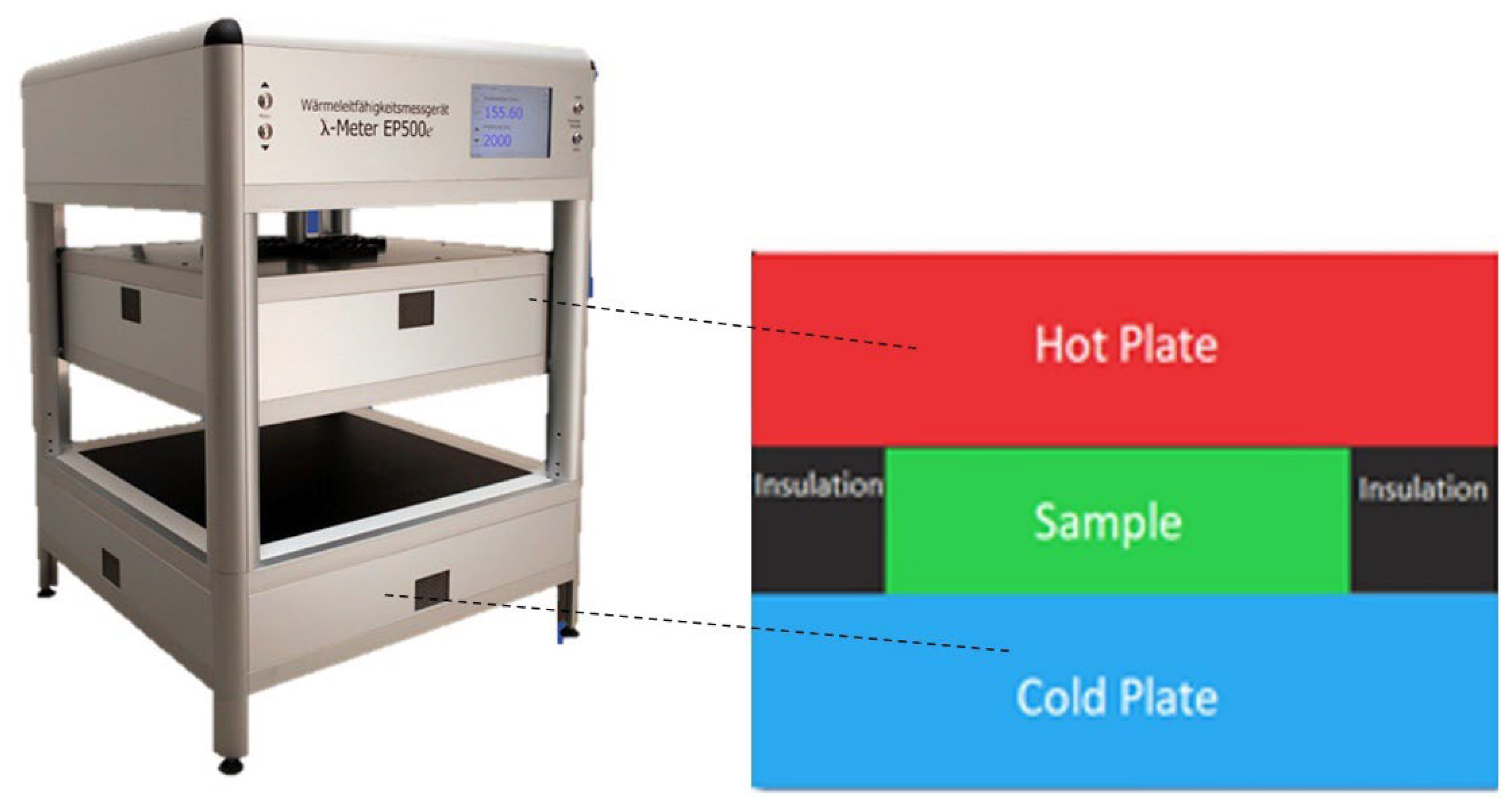
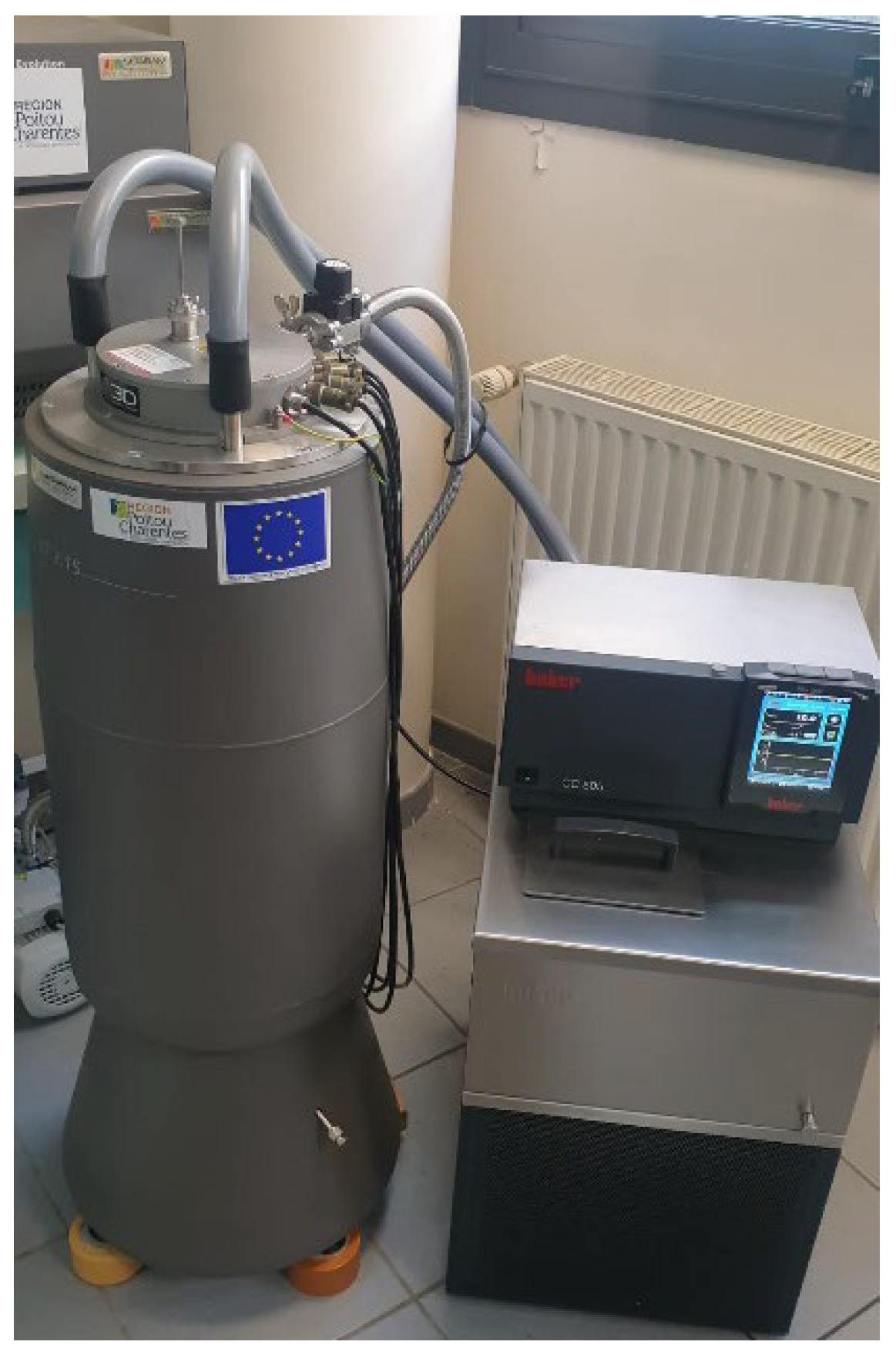

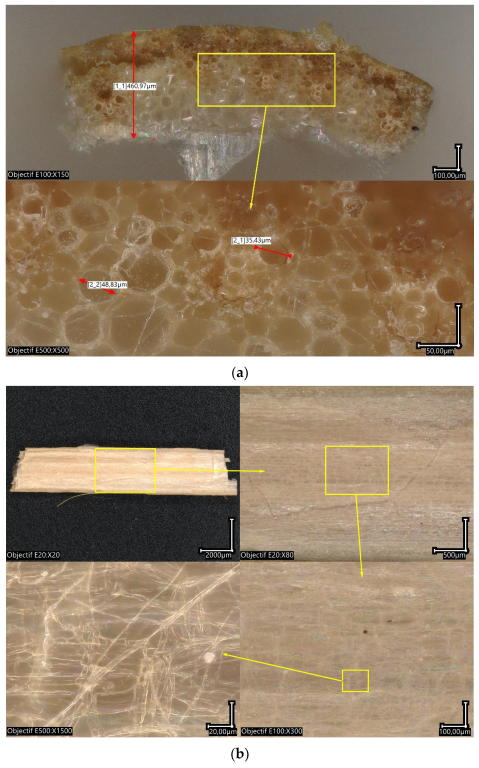
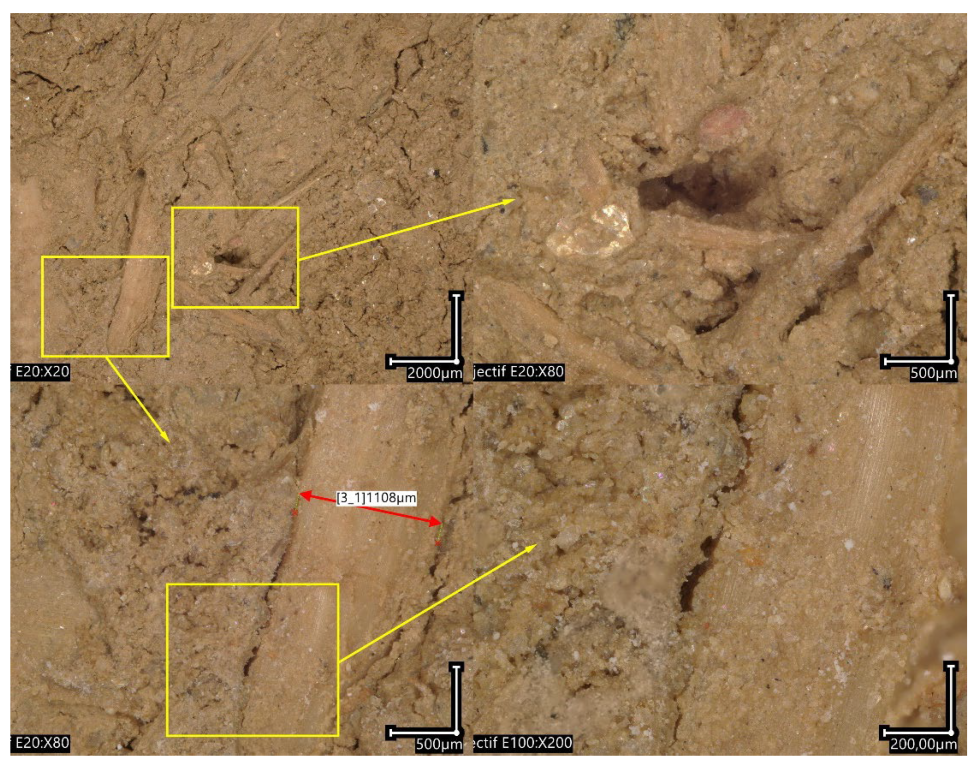
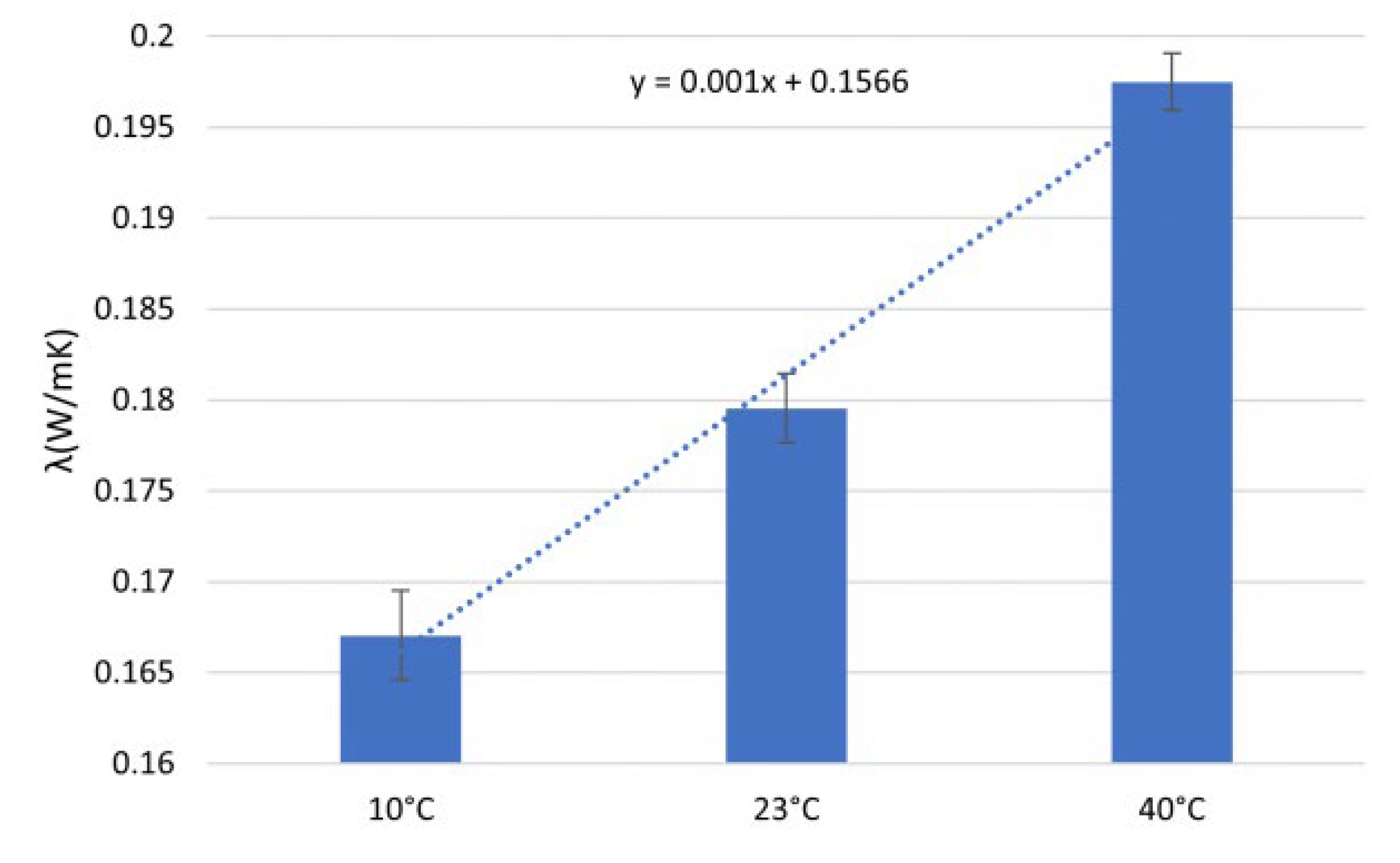
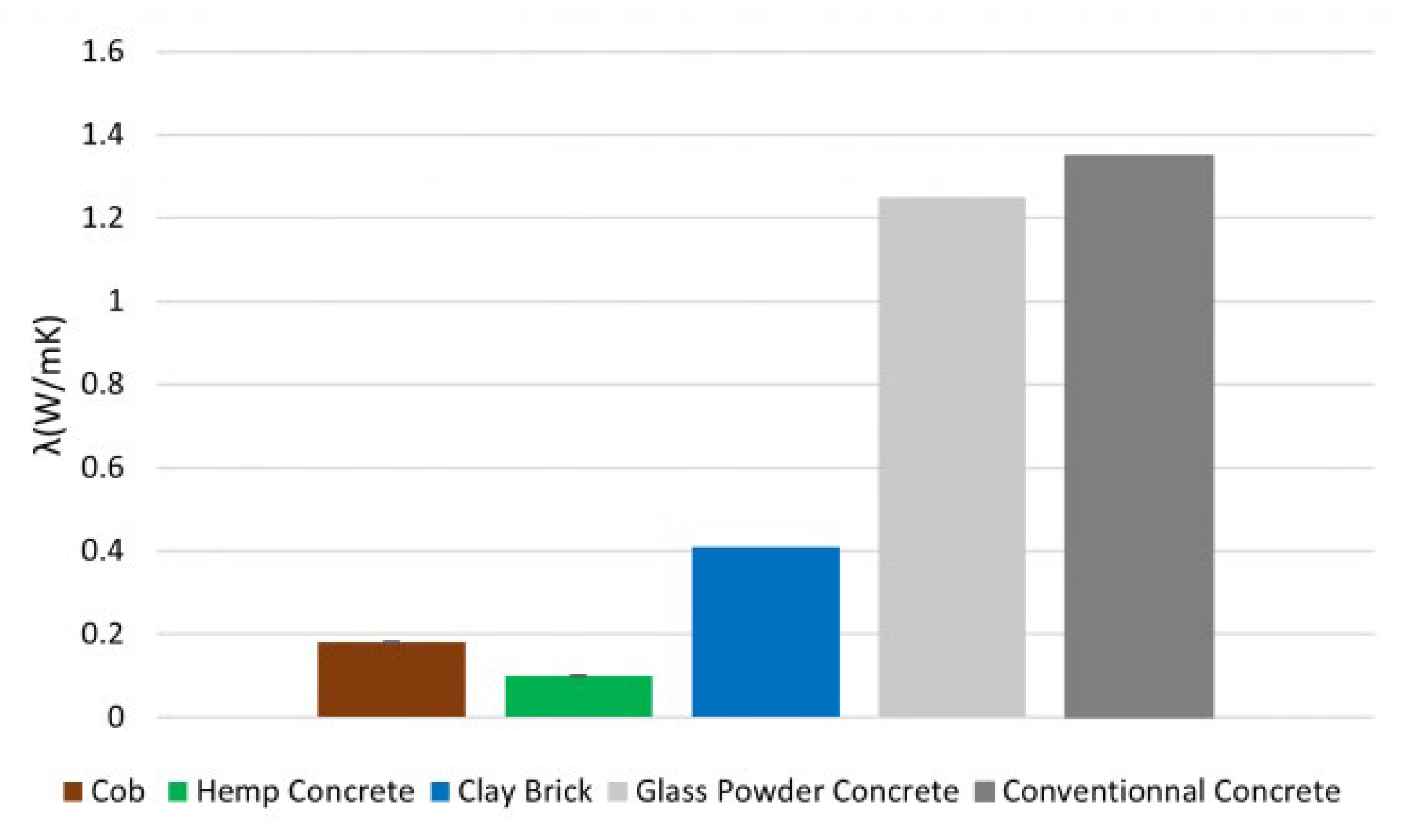
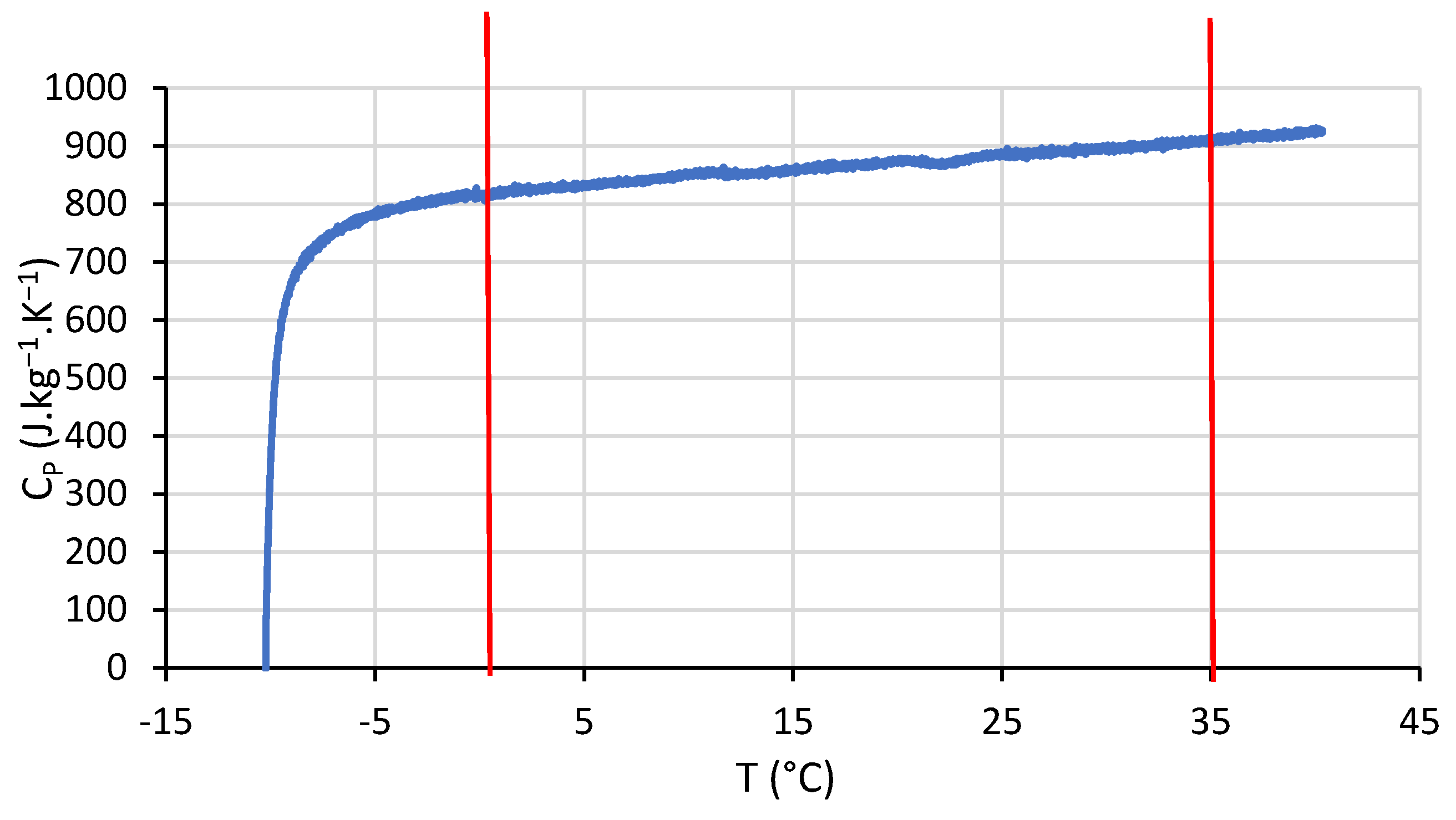
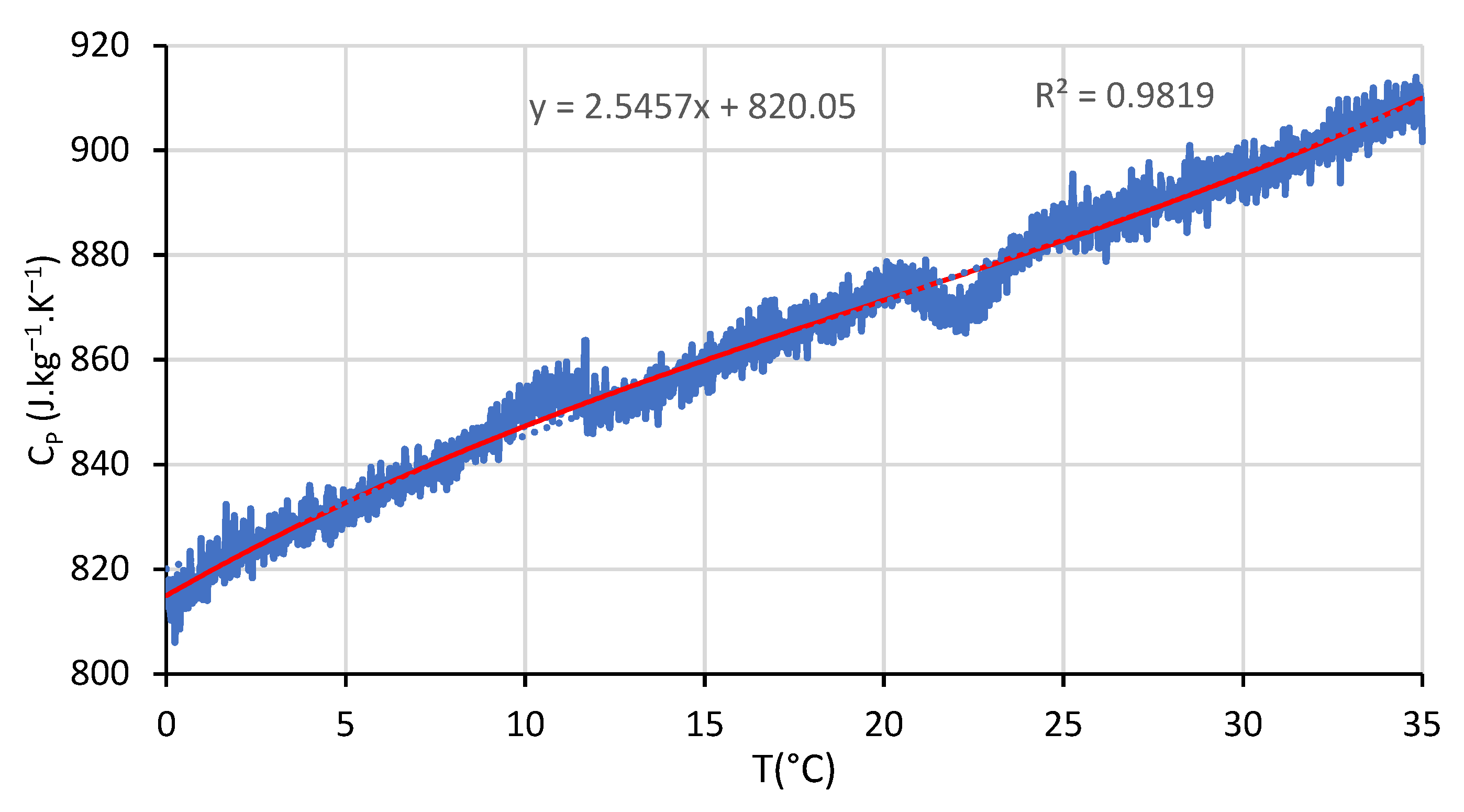
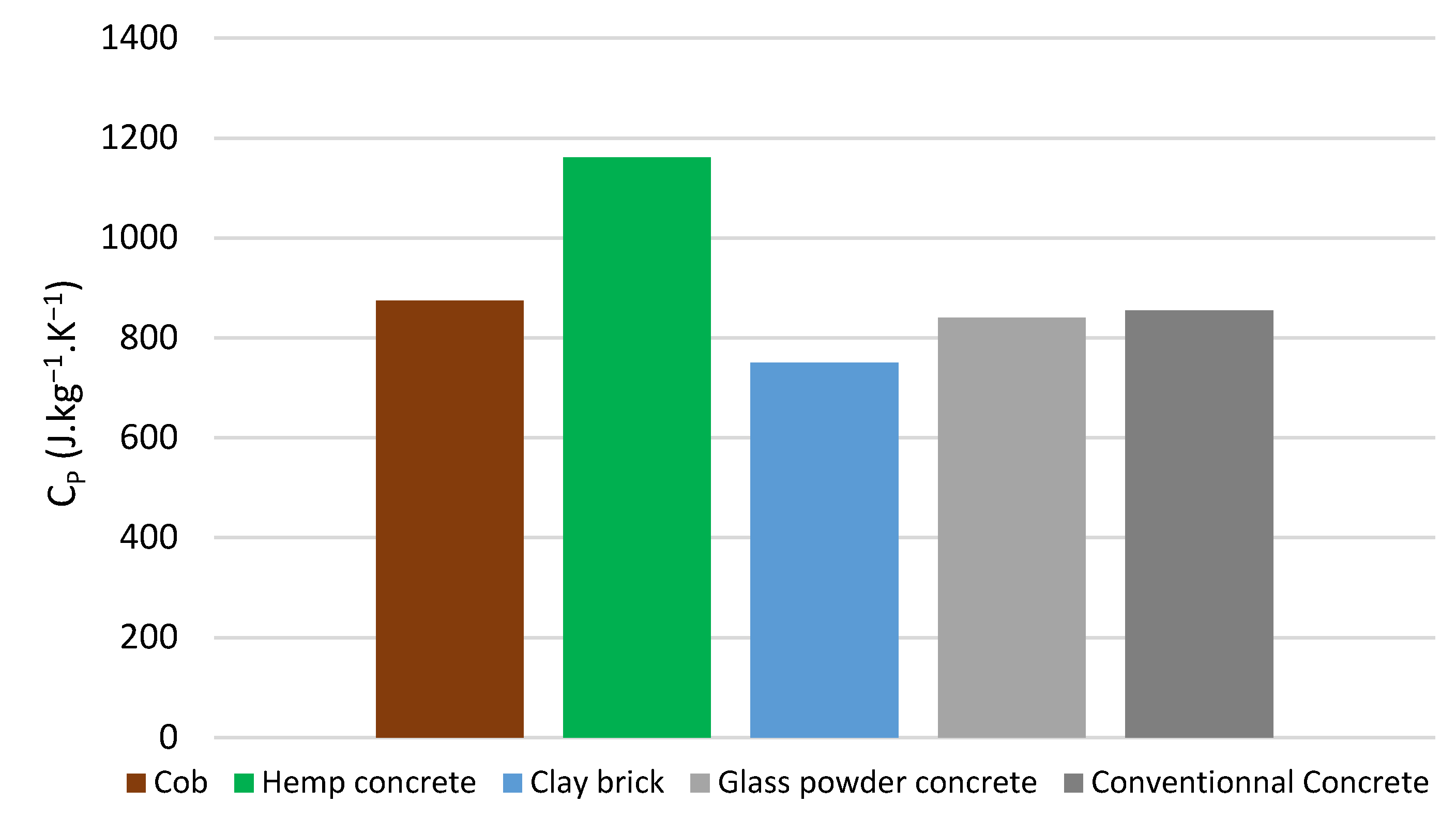
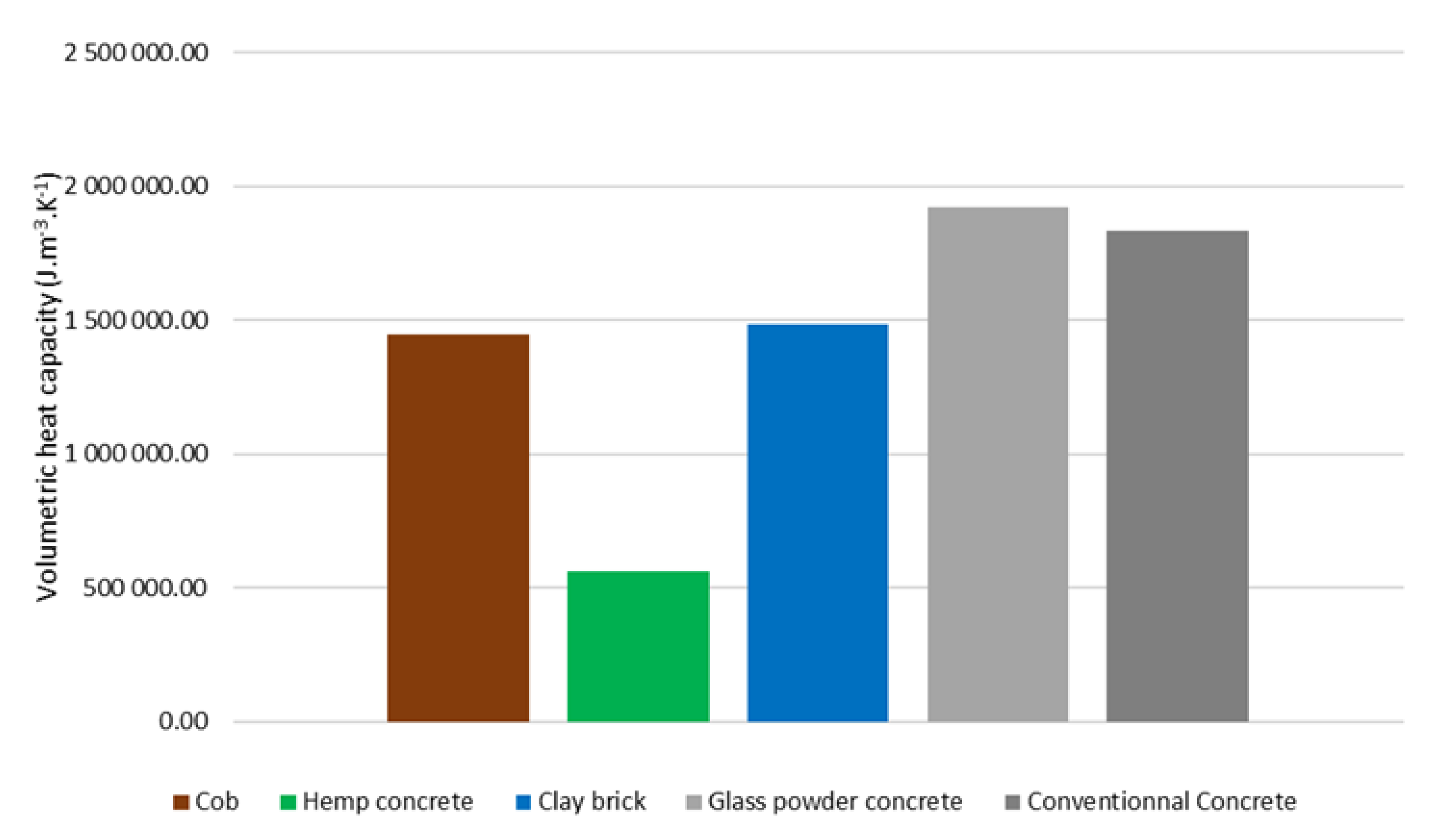



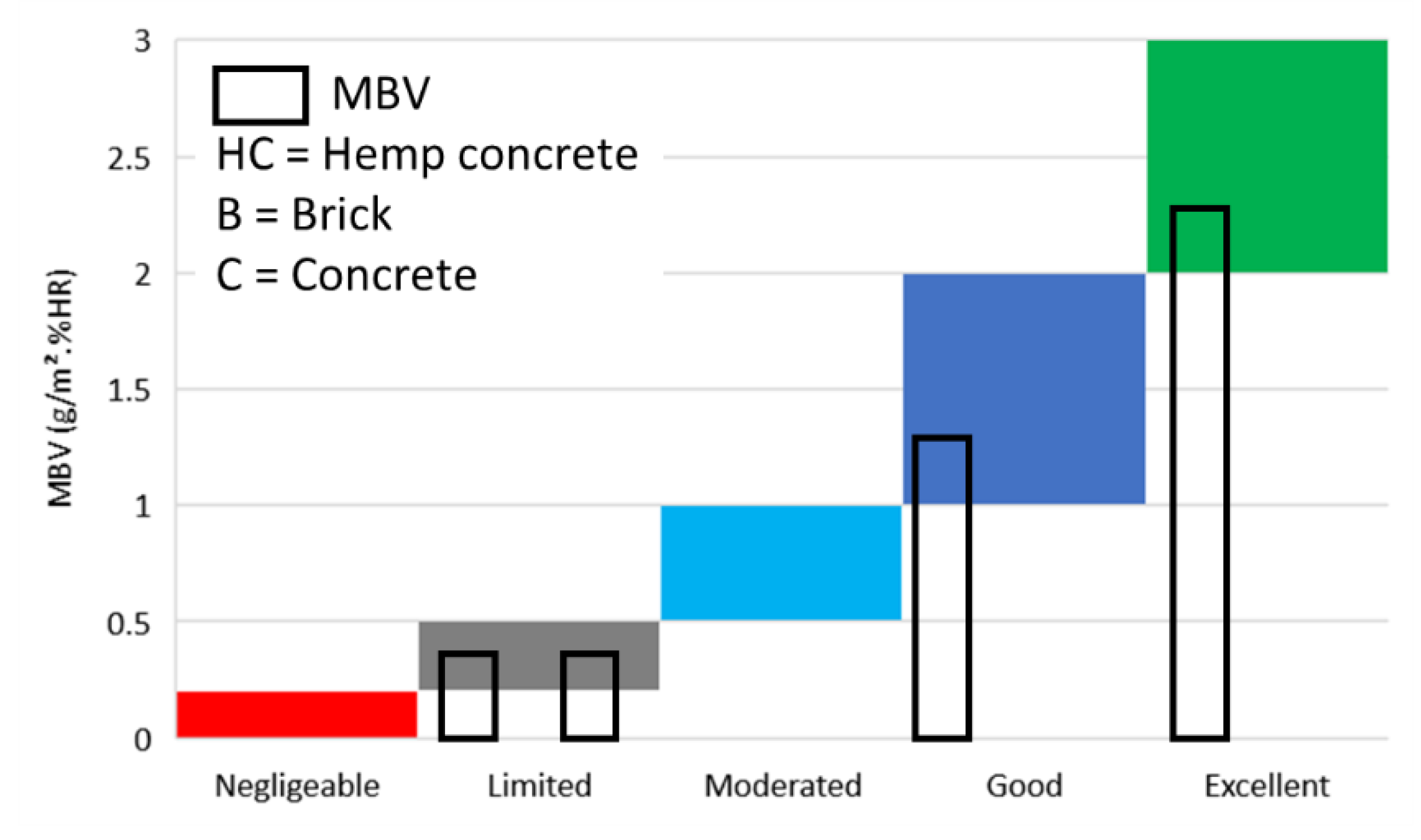
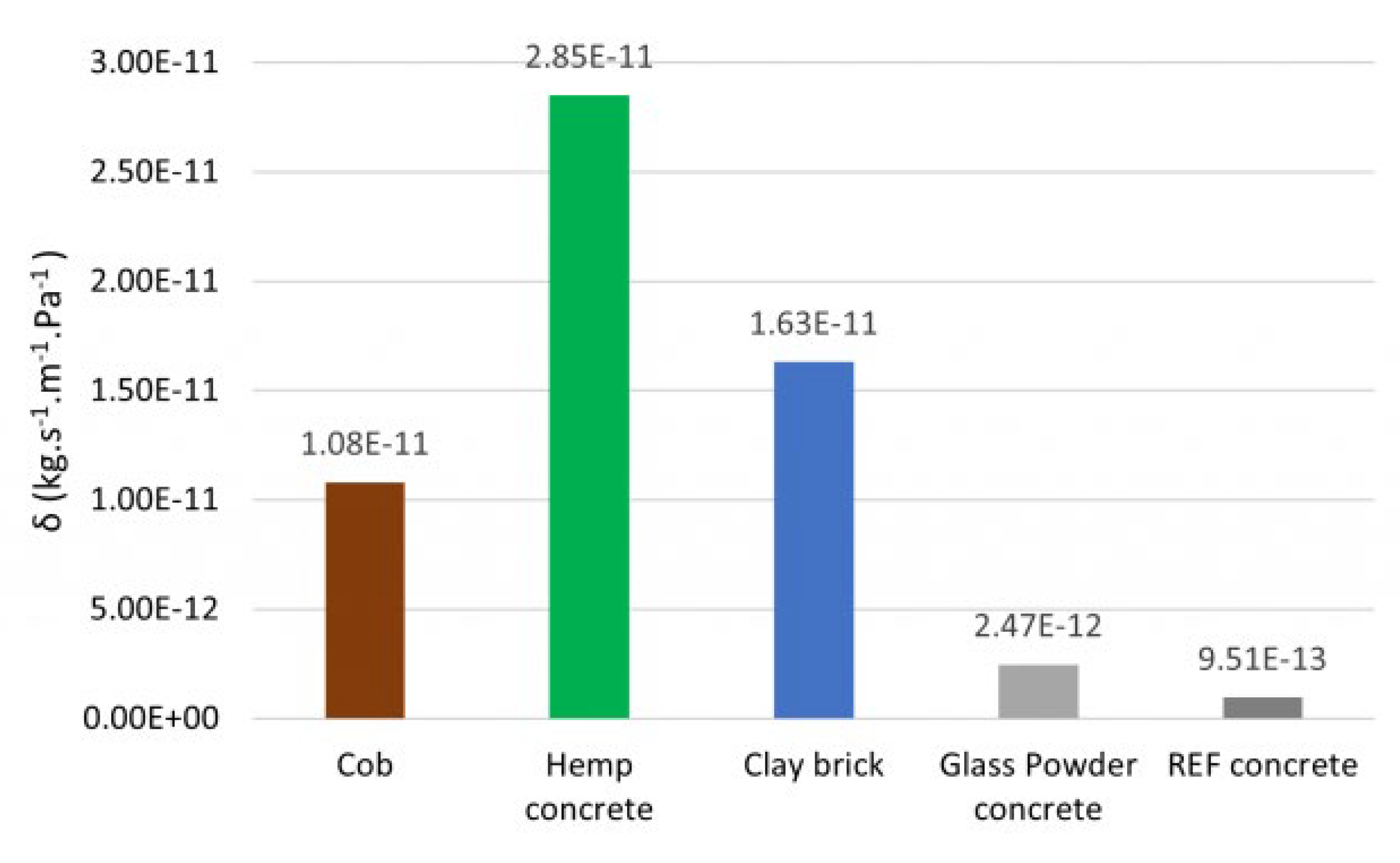
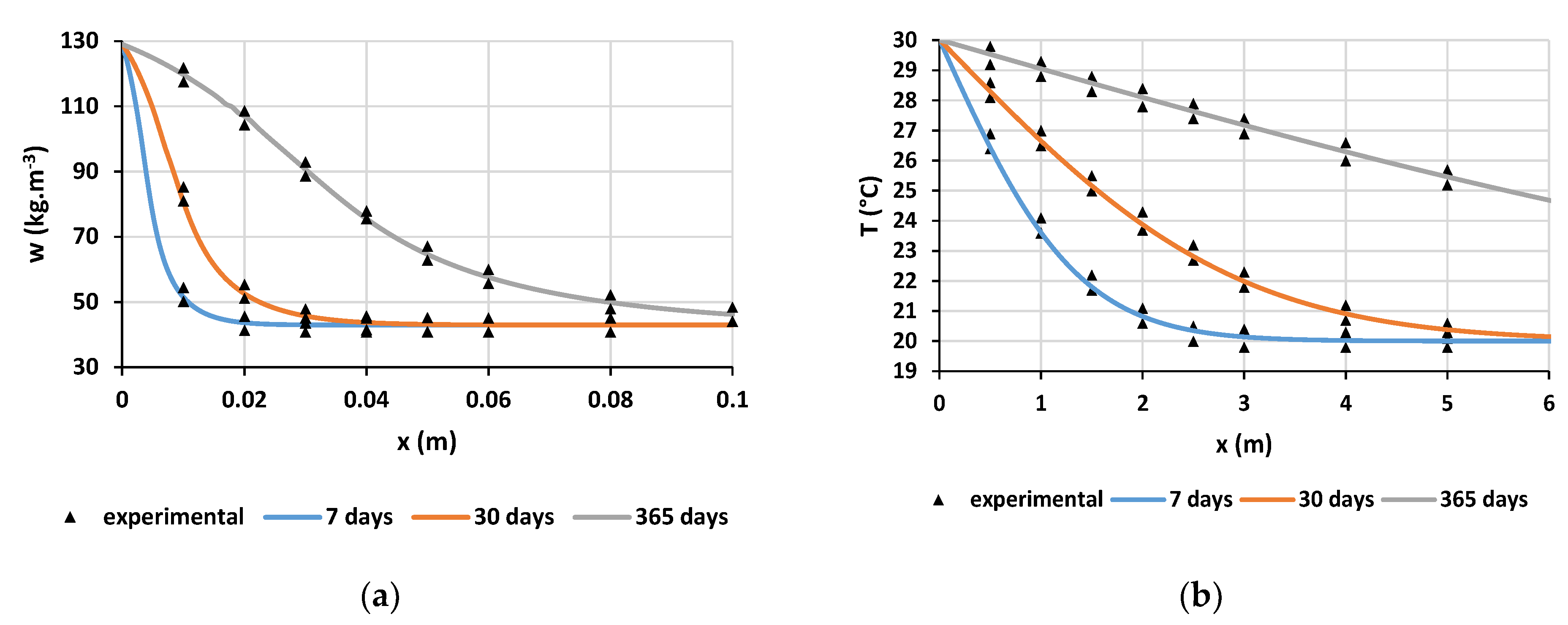
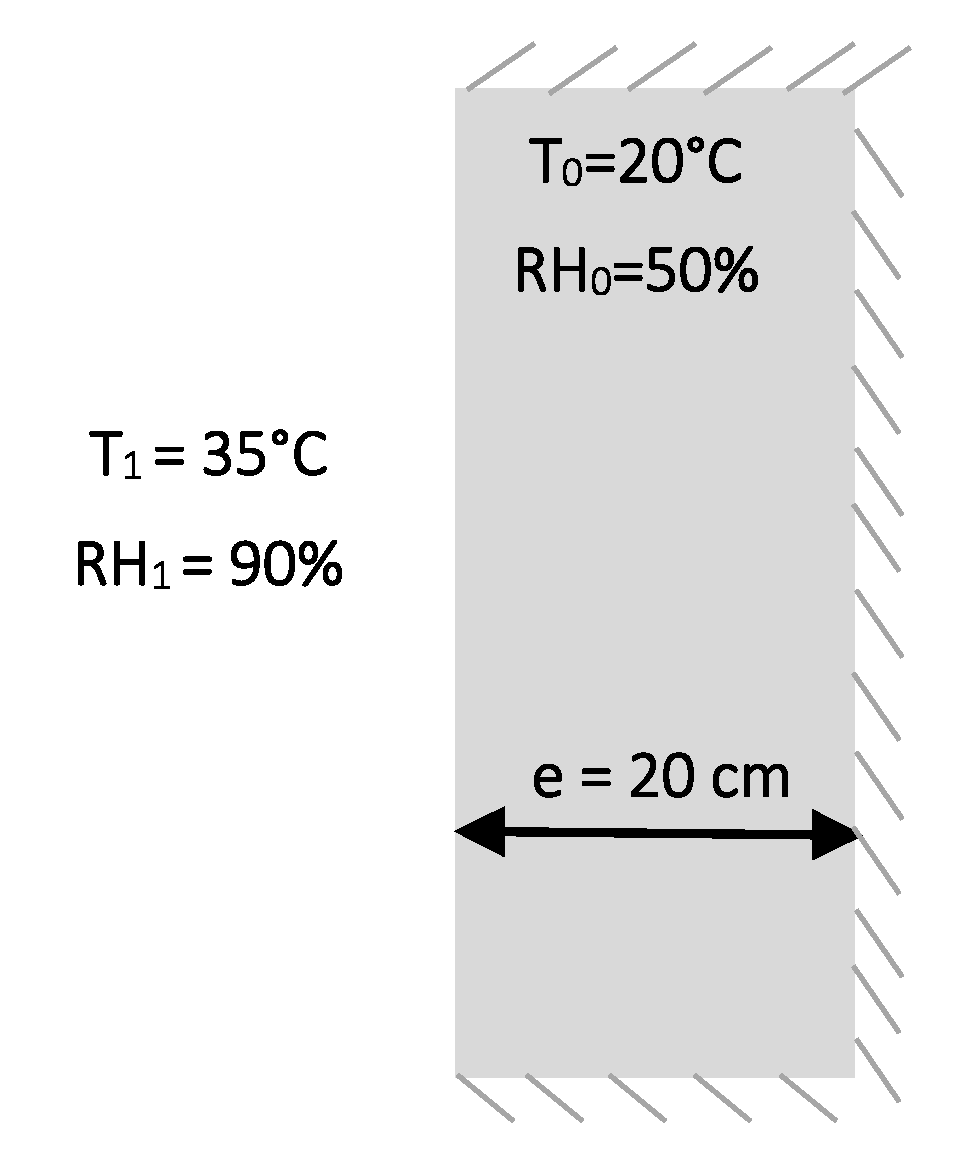
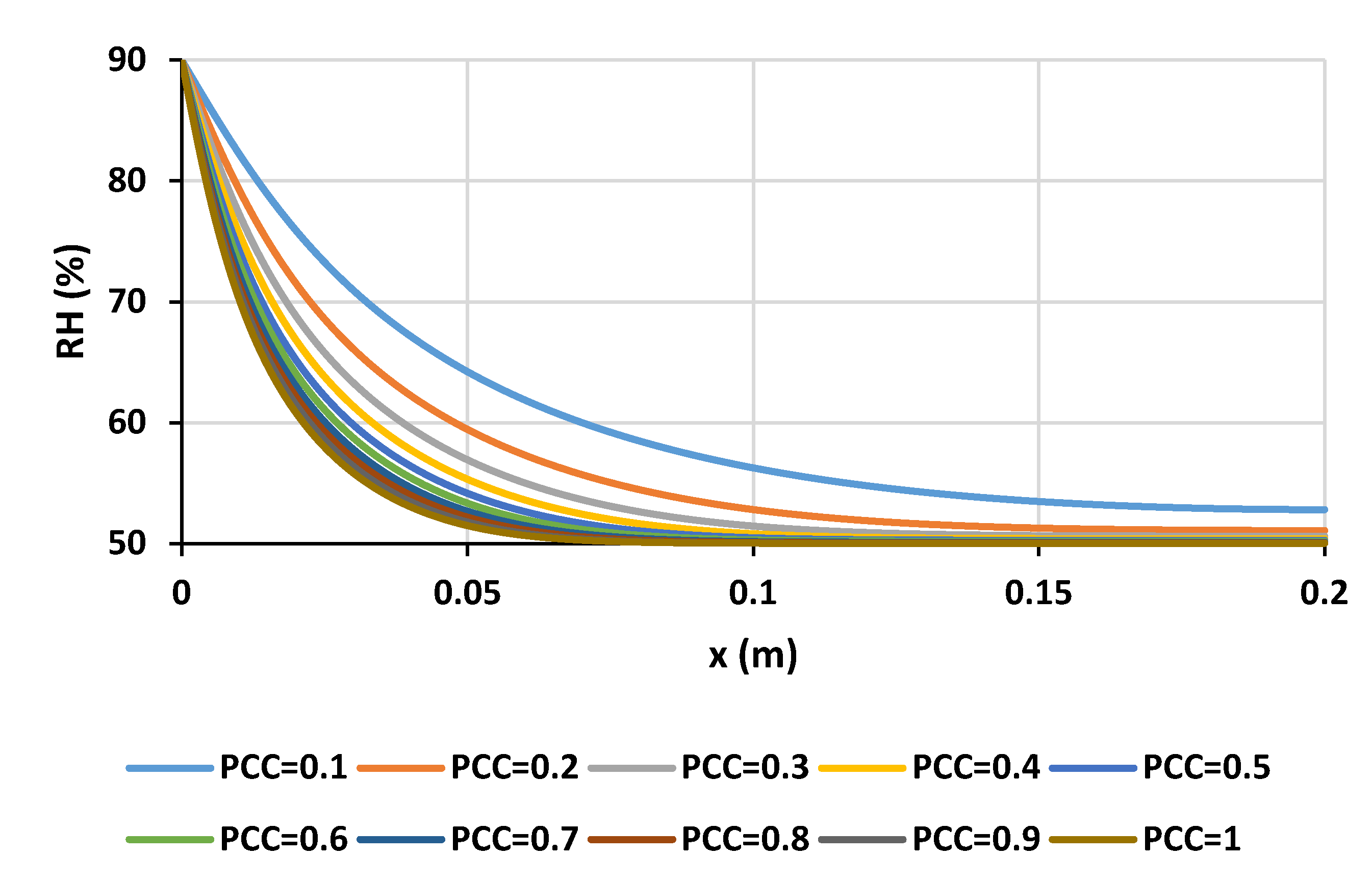
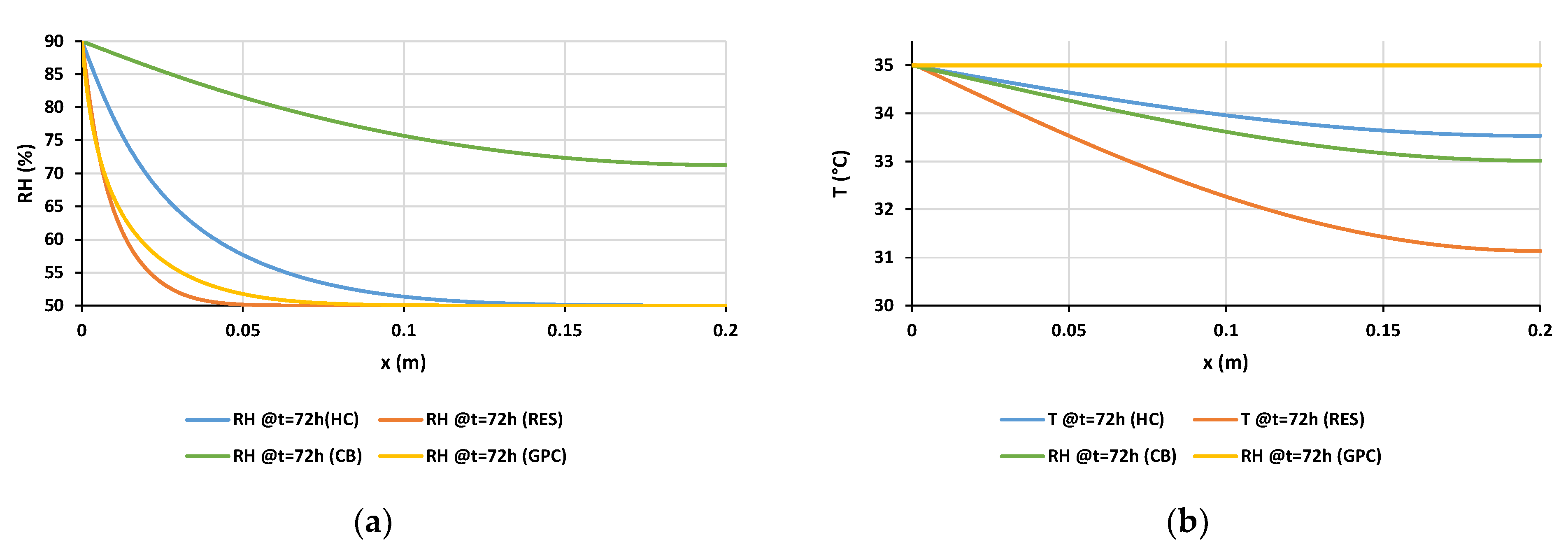
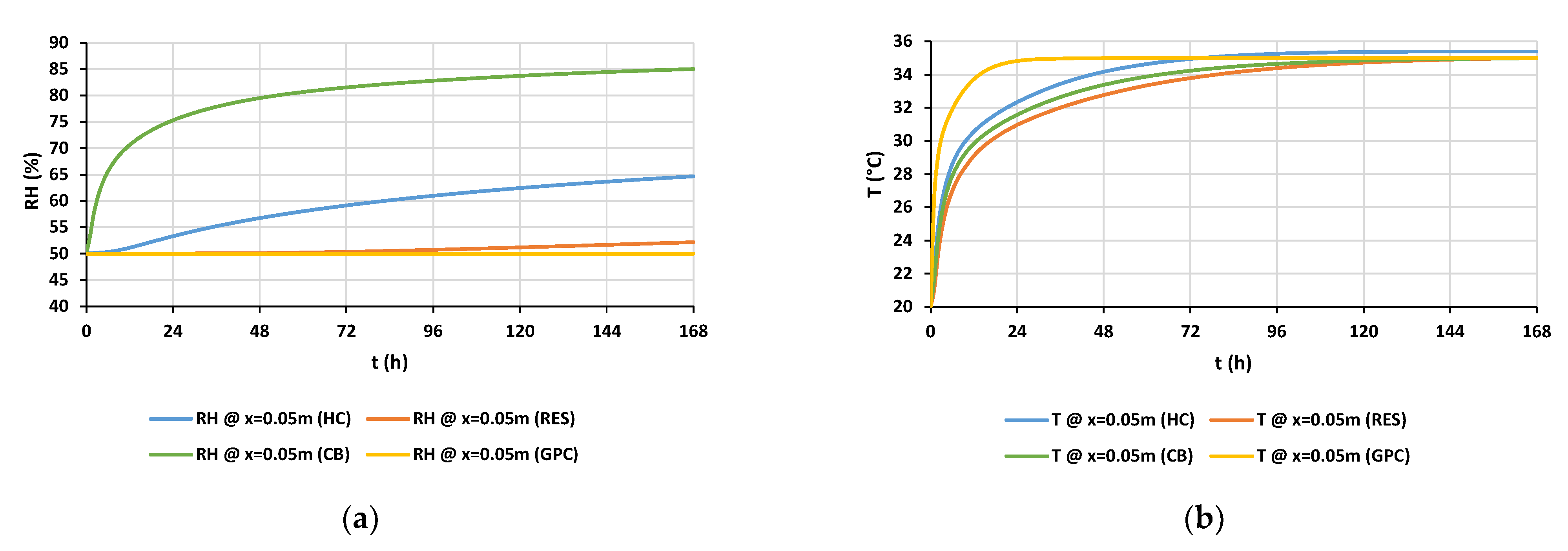
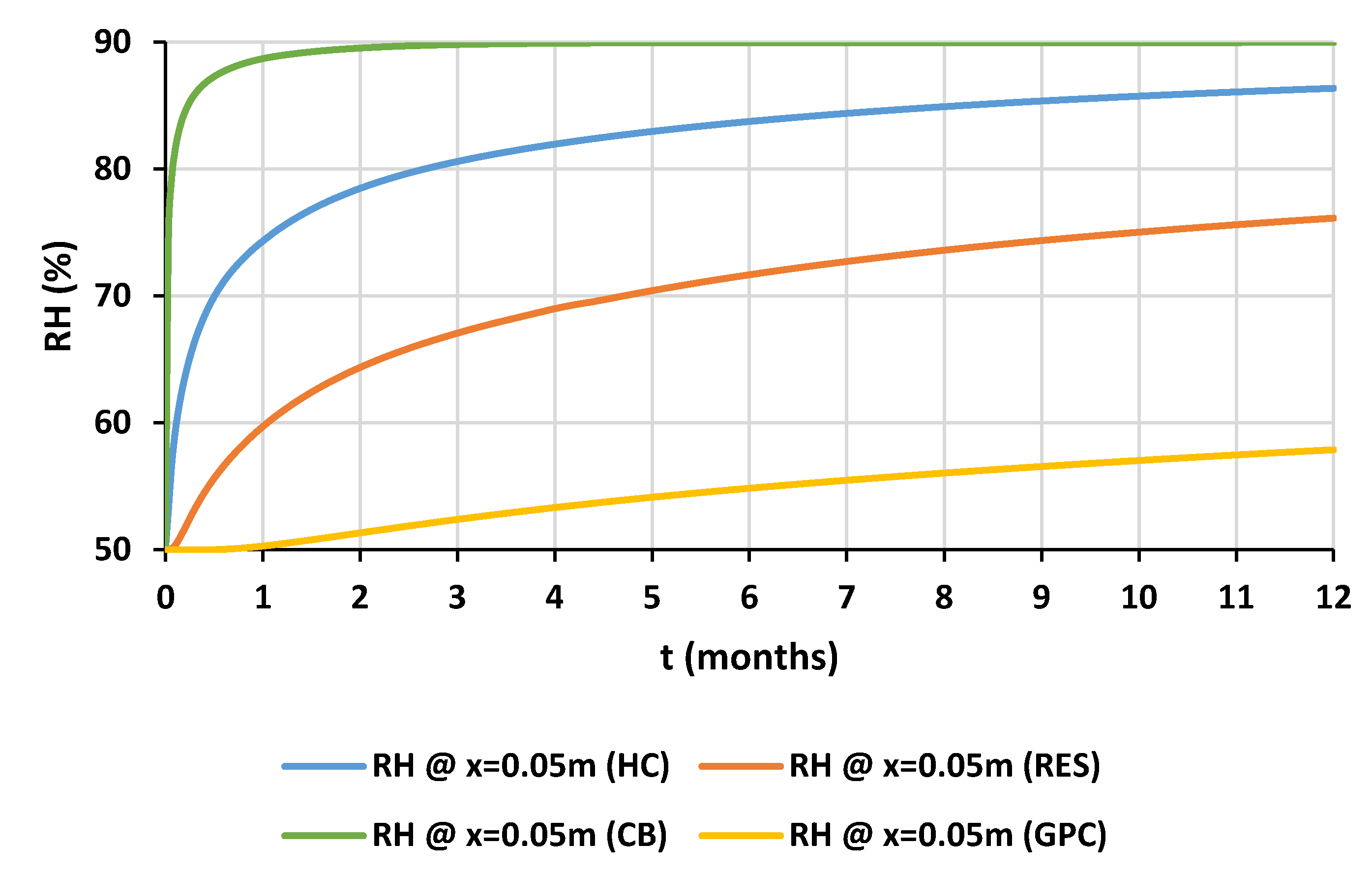
| Materials | Water Vapor Resistance Factor |
|---|---|
| Cob | 18.52 |
| Hemp concrete | 7.02 |
| Clay brick | 12.27 |
| Glass powder concrete | 80.97 |
| REF concrete | 210.30 |
| Materials | Thermal Conductivity (W·m−1·K−1) | Water Vapor Permeability (kg·s−1·m−1·Pa−1) | Heat Capacity (J·kg−1·K−1) | Dry Density (kg·m−3) |
|---|---|---|---|---|
| Hemp concrete [56,63] | 0.1 | 2.85× 10−11 | 1150 | 484.56 |
| Clay brick [53] | 0.41 | 1.63× 10−11 | 750 | 1980 |
| Glass powder concrete [52] | 1.29 + 0.607 · w/1000 | 3.38 × 10−11 · exp(−5.998 · RH) | 850 | 2290 |
| RES | 0.18 | 1.08 × 10−11 | 870 | 1654 |
Publisher’s Note: MDPI stays neutral with regard to jurisdictional claims in published maps and institutional affiliations. |
© 2022 by the authors. Licensee MDPI, Basel, Switzerland. This article is an open access article distributed under the terms and conditions of the Creative Commons Attribution (CC BY) license (https://creativecommons.org/licenses/by/4.0/).
Share and Cite
Belarbi, Y.E.; Sawadogo, M.; Poullain, P.; Issaadi, N.; Hamami, A.E.A.; Bonnet, S.; Belarbi, R. Experimental Characterization of Raw Earth Properties for Modeling Their Hygrothermal Behavior. Buildings 2022, 12, 648. https://doi.org/10.3390/buildings12050648
Belarbi YE, Sawadogo M, Poullain P, Issaadi N, Hamami AEA, Bonnet S, Belarbi R. Experimental Characterization of Raw Earth Properties for Modeling Their Hygrothermal Behavior. Buildings. 2022; 12(5):648. https://doi.org/10.3390/buildings12050648
Chicago/Turabian StyleBelarbi, Yassine Elias, Mohamed Sawadogo, Philippe Poullain, Nabil Issaadi, Ameur El Amine Hamami, Stéphanie Bonnet, and Rafik Belarbi. 2022. "Experimental Characterization of Raw Earth Properties for Modeling Their Hygrothermal Behavior" Buildings 12, no. 5: 648. https://doi.org/10.3390/buildings12050648






